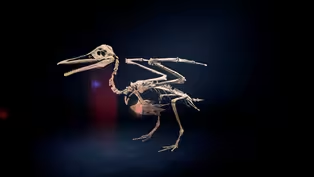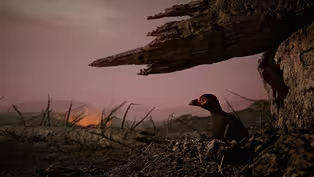
How Birds Evolved to Fly (feat. Slow-Mo Baby Birds)
Clip: Season 52 Episode 3 | 2m 56sVideo has Closed Captions
Slow-motion footage of baby birds helps scientists uncover how their ancestors took to the skies.
Birds today make flight look effortless, but its evolution was complex. Scientists are still trying to discover exactly how birds took to the skies, and today, a new perspective has emerged by studying how flightless chicks become skilled flyers. With high-speed cameras and careful observation, discover how researchers are gaining insights into the development of bird flight.
Problems playing video? | Closed Captioning Feedback
Problems playing video? | Closed Captioning Feedback
National Corporate funding for NOVA is provided by Carlisle Companies and Viking Cruises. Major funding for NOVA is provided by the NOVA Science Trust, the Corporation for Public Broadcasting, and PBS viewers.

How Birds Evolved to Fly (feat. Slow-Mo Baby Birds)
Clip: Season 52 Episode 3 | 2m 56sVideo has Closed Captions
Birds today make flight look effortless, but its evolution was complex. Scientists are still trying to discover exactly how birds took to the skies, and today, a new perspective has emerged by studying how flightless chicks become skilled flyers. With high-speed cameras and careful observation, discover how researchers are gaining insights into the development of bird flight.
Problems playing video? | Closed Captioning Feedback
How to Watch NOVA
NOVA is available to stream on pbs.org and the free PBS App, available on iPhone, Apple TV, Android TV, Android smartphones, Amazon Fire TV, Amazon Fire Tablet, Roku, Samsung Smart TV, and Vizio.
Buy Now

NOVA Labs
NOVA Labs is a free digital platform that engages teens and lifelong learners in games and interactives that foster authentic scientific exploration. Participants take part in real-world investigations by visualizing, analyzing, and playing with the same data that scientists use.Providing Support for PBS.org
Learn Moreabout PBS online sponsorship(birds chirping) - [Narrator] Today, bird flight is spectacularly complex.
They soar with ease, but the transition from a ground-based life to one in the skies would not have been an easy one.
It's something that scientists are still trying to understand.
How did birds first take flight?
There are several ideas of how this happened.
The first known as the tree down hypothesis suggests that tree-dwelling birds flap their wings to cushion their landing.
The second, known as the ground up hypothesis, emphasizes the use of wing flapping associated with running to escape danger or catch up with prey.
(bird cawing) But recently another theory has been suggested, one that can be seen in birds today.
(bright music) - So these are our performers today.
So this is Olympia and Greg here.
This is Annie and Brown, and this is Twinkle Jemima or Twinkie for short.
- [Narrator] To analyze the movement of the wings in detail, evolutionary biologist Ashley Heers needs to see them in slow motion.
- Here I've got my high speed video camera and I can visualize what the camera is seeing on the laptop.
(birds squawking) And so you can see that she's really using her wings to break as she gets ready to land there.
I actually spend a lot of my time working with developing birds or baby birds 'cause it can also tell us a lot about the evolution of life.
And in many ways, they look similar to some of the fossils that we see that are documenting this origin of life.
And so in these developing birds, we have this really interesting system where we can see in real time how a living animal goes from a flightless animal to a flight-capable animal.
And everything that happens in between both anatomically and behaviorally.
(soft bright music) - [Narrator] One of the behaviors seen is wing-assisted running on an incline plane.
- So on the left here, we have a four day old Chukar partridge.
It is flapping its wings to really drive itself into the substrate here and increase traction with its feet so that it can ascend this steep incline.
- [Narrator] This is not the only behavior that hints that dinosaurs were able to develop flapping flight.
- They may use their wings to leap into the air and fly either for a very short distance or for thousands of miles.
They also use their wings to come down out of trees or off of elevated surfaces, even to swim either across the water or below the water.
And so living birds show us that they use lots of different habitats and they use their wings for lots of different functions.
- [Narrator] Bird flight developed as an adaptation to the environment, as well as to allow gliding down from trees or to evade predators on land.
(dramatic music)
Video has Closed Captions
Preview: S52 Ep3 | 29s | Fossils reveal how birds survived the killer asteroid and became today’s only living dinosaurs. (29s)
How Birds Survived the Dinosaur Apocalypse
Video has Closed Captions
Clip: S52 Ep3 | 2m 48s | Birds are today’s only living dinosaurs, but how did they survive the asteroid? (2m 48s)
Providing Support for PBS.org
Learn Moreabout PBS online sponsorship
- Science and Nature

Capturing the splendor of the natural world, from the African plains to the Antarctic ice.

- Science and Nature

Learn how centuries of knowledge helped our ancestors understand the mysteries of space.












Support for PBS provided by:
National Corporate funding for NOVA is provided by Carlisle Companies and Viking Cruises. Major funding for NOVA is provided by the NOVA Science Trust, the Corporation for Public Broadcasting, and PBS viewers.



